|
King Siri Kula Sundhura
Katthiribavana (reigned 1892 and 1903-1933)
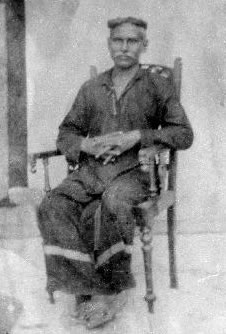
Siri Kula Sundhura Katthiribavana, King of Twelve Thousand Isles
and Sultan of the Maldives, also known as Mohamed Shamsuddine III
Iskander. A patron of the arts, he was the son of the King Ibrahim
Nooreddine Iskander (reigned 1882-1886 and 1888 - 1892) and Kakaagey
Goma. This is a rare photograph taken in casual dress. Mohamed Shamsuddine
III Iskander was the last monarch who ruled under the old unwritten
constitution. Other than a few previous Maldive monarchs who had
not reached the age of majority, he was the first non-absolute monarch.
From the inception of his reign in 1903, he ruled on the advice
of his prime minister and the council of ministers. Contrary to
the generally held view, the written constitution of 1932 was not
introduced to curb the powers of an absolute monarch; rather it
was the result of disagreements between the older ministers and
a new generation of overseas educated nobles and a few opportunistic
mullahs headed by the chief justice Hussain Salahuddine. As always,
the mullahs' aim was to force an Islamic state over the Maldives.
Veyogey Don Goma

The Princess Don Goma daughter of the King Ibrahim Nooreddine and
Kakagey Goma. This photograph was taken while she was receiving
medical treatment at a hospital abroad- hence the most unusual attire.
Her eldest son became the final monarch of our dynasty and that
of the Maldives. Don Goma kept a rather informed journal of her
memoirs, which included social and political events of the time.
It was never published and years after her death, the manuscript
was seized from her family and allegedly destroyed by the Maldive
authorities. The destruction of material written by those who are
not acceptable to the authorities is widespread in the Maldives
even to this day. Perhaps the precedent was set by the Caliph Omar
bin el-Khattab in AD 640 when he ordered the burning of the books
in the Great Library of Alexandria, Egypt. Omar justified the book-burning
by saying that "they will either contradict the Koran, in which
case they are heresy, or they will agree with it, so they are superfluous."
Ibrahim Habeeb Manippulu
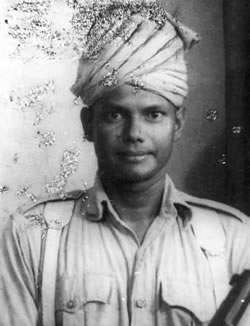
The Prince Ibrahim Habeeb Manippulu while training with an Imperial
Indian regiment in the Punjab in 1943-44. He was the youngest son,
one of twins, of the Princess Don Goma daughter of the King Ibrahim
Nooreddine Iskander. Ibrahim Habeeb Manippulu was a trained soldier
and an accomplished musician. He was one of only two subjects of
the Sultan of the Maldives who volunteered for military service
in the Imperial and Allied Forces during World War II. In the academic
field he displayed an aptitude for physics and mathematics. It was
under his direction that the royal militia regiment known as Sifain
first introduced a Western style brass band. Under the republic
the Sifain are now known as the National Security Service
(NSS). One of the other royal militia regiments called the Hañgun
operated a native style brass band for some centuries. The native
style band was abolished in 1964.
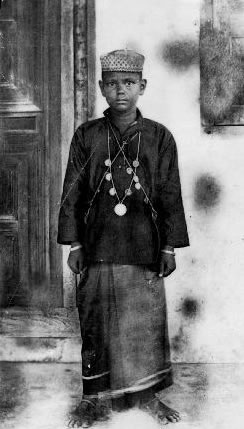
The Prince Ibrahim Habeeb Manippulu aged 7
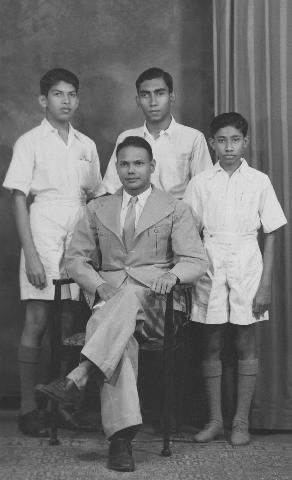
The Prince Ibrahim Habeeb Manippulu as the warden of a Maldive government
run hostel for young gentlemen in Colombo in the mid 1940s. The
three pupils behind him are from left: Ali Reza, Majehigey
Mohamed Didi and Abdul Razak Abdul Wahhab (the site editor's
eldest brother)
Henveyrugey
Ali Kuda Rannabandeyri Kilegefan

A Peer of the Realm, Henveyrugey Ali Didi later Kuda Rannabandeyri
Kilegefan was for many years the President of the Council of Regency
in the 1940s and early 1950s- the Maldives governing body in the
absence of a monarch during the time of the monarchy. He was also
one of the most experienced and sought-after practitioners of native
medicine in his time.
Hassan
Farid Didi
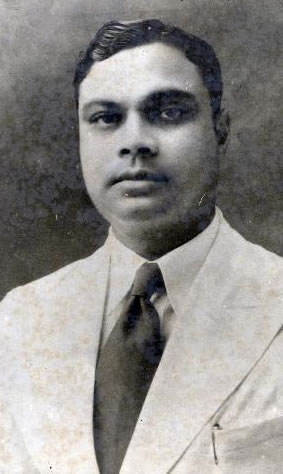
The Prince Hassan Farid Didi Minister of the Interior
and de facto head of government in the 1930s and early
1940s. He was presumed dead when the British warship HMS Maaløy
he was on board as a civilian passenger en route from Addu Atoll
to Colombo was sunk by the German Navy during World War II
Aboard
a British warship in Malé anchorage
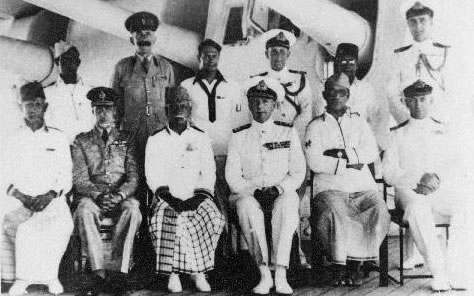
On the British commander's right is Henveyrugey
Ali Kuda Rannabandeyri Kilegefan President of the ruling Council
of Regency; on the commander's left is Athireegey Mohamed Amin Didi,
later Dorhimeyna Kilegefan Acting Prime Minister and chief of staff
of the royal militia regiment called the Sifain. Standing
on the commander's right is the Prince Ibrahim Habeeb Manippulu
deputy chief of staff of the Sifain. Standing on the far
left is Velaanaagey Ibrahim Didi, third ranking officer of the Sifain
Officers
and men of the royal miltia regiment called the Sifain
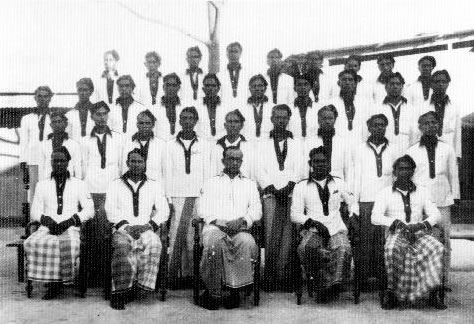
In native uniform circa 1951. Seated in the
middle is Athireegey Mohamed Amin Dorhimeyna Kilegefan Acting Prime
Minister and chief of staff and on his right is Prince Ibrahim Habeeb
Manippulu deputy chief of staff
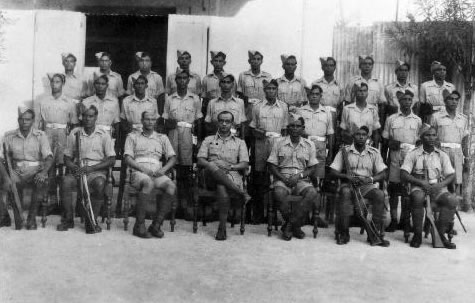
In Western uniform circa 1951. Seated in the middle is Athireegey
Mohamed Amin Dorhimeyna Kilegefan Acting Prime Minister and chief
of staff and on his right is Prince Ibrahim Habeeb Manippulu deputy
chief of staff
Investiture
ceremony
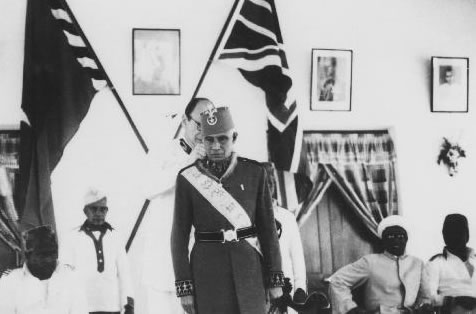
Mohamed Farid, King of Twelve Thousand Isles and
Sultan of the Maldives (reigned 1954-1968) son of Athireegey Abdul
Majeed Rannabandeyri Kilegafan and the Princess Don Goma daughter
of the King Ibrahim Nooreddine Iskander. He is being invested as
a Knight Commander of the Most Distinguished Order of St. Michael
and St. George (K.C.M.G) at Malé in 1961. Seated on the left
is the Prime Minister Velaanaagey Ibrahim Nasir later Rannabandeyri
Kilegafan. Seated on the right in mullah robes is the Chief Justice
Mohamed Jameel Didi. Standing on the left is the royal aides-de-camp
Maizandorhugey Hussain Kaleyfanu. Standing on the right, partially
concealed, is Badialibeygey Medu Seedi, the chief of staff of the
royal court (Maabañdeyri). Mohamed Farid was the
final monarch of our dynasty and of the Maldives.
| 



 rss feed
rss feed 











